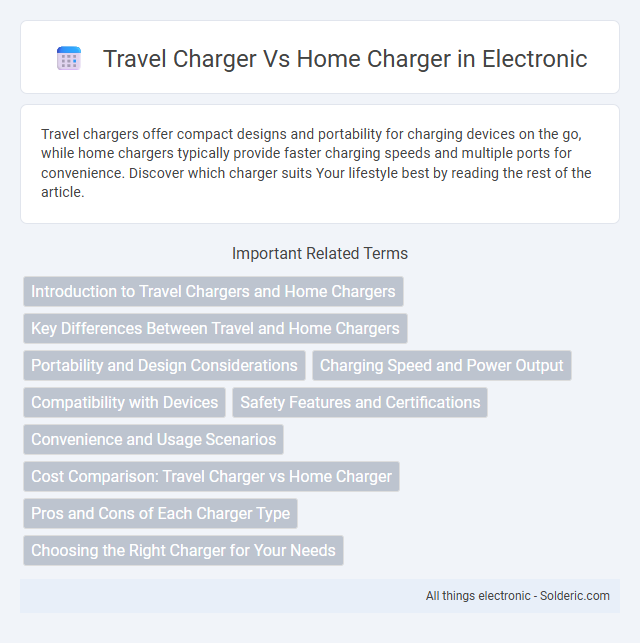Travel chargers offer compact designs and portability for charging devices on the go, while home chargers typically provide faster charging speeds and multiple ports for convenience. Discover which charger suits Your lifestyle best by reading the rest of the article.
Comparison Table
| Feature | Travel Charger | Home Charger |
|---|---|---|
| Portability | Compact and lightweight for easy transport | Typically larger, designed for stationary use |
| Power Output | Lower wattage, usually 18-30W | Higher wattage, ranges from 40W to 100W+ |
| Charging Speed | Moderate, suitable for on-the-go charging | Faster charging, ideal for daily home use |
| Compatibility | Universal, multi-device support | Often device-specific or brand-oriented |
| Power Source | USB ports, wall sockets, or car adapters | Dedicated electrical outlet connections |
| Durability | Designed for frequent handling and travel conditions | Durable but less portable |
| Price | Generally affordable and budget-friendly | Higher cost due to performance and build |
Introduction to Travel Chargers and Home Chargers
Travel chargers are compact, portable devices designed for charging electronic gadgets on the go, often featuring multiple USB ports and compatibility with various voltage standards. Home chargers typically offer higher wattage and faster charging speeds, optimized for stationary use with dedicated power outlets and enhanced safety features. Choosing between travel chargers and home chargers depends on mobility needs, power requirements, and device compatibility.
Key Differences Between Travel and Home Chargers
Travel chargers are typically compact, lightweight, and designed for portability with foldable plugs and multiple USB ports, while home chargers prioritize higher power output and stable charging for devices at a fixed location. Travel chargers often support universal voltage compatibility (100-240V) to work internationally, whereas home chargers focus on optimized performance for the local power grid. Your choice depends on whether you need convenience and versatility on the go or consistent, fast charging at home.
Portability and Design Considerations
Travel chargers emphasize compactness and lightweight design to facilitate easy packing and mobility during trips. Home chargers often prioritize durability and higher power output, resulting in larger and sturdier builds suited for stationary use. Portability demands in travel chargers lead to foldable plugs and sleek profiles, whereas home chargers focus on stable placement and cooling systems.
Charging Speed and Power Output
Travel chargers typically offer lower power output, ranging from 18W to 30W, which results in slower charging speeds compared to home chargers. Home chargers often provide higher wattage, such as 65W or 100W, enabling faster charging and efficient power delivery for devices like laptops and smartphones. The increased power output of home chargers supports rapid battery replenishment and prolonged device usage without frequent charging interruptions.
Compatibility with Devices
Travel chargers often feature universal compatibility with multiple device types and voltage standards, making them ideal for use with smartphones, tablets, laptops, and other electronics across different countries. Home chargers may be designed specifically for certain brands or device models, providing optimized power delivery but limited flexibility with other devices. Selecting a charger depends on the need for versatility in device compatibility versus dedicated performance for particular electronics.
Safety Features and Certifications
Travel chargers often feature multiple safety protections such as overcurrent, overvoltage, and short-circuit safeguards to ensure reliable use on the go. Home chargers typically include certifications like UL, CE, and FCC, which guarantee compliance with regional electrical safety standards and quality assurance. Choosing a certified charger maintains your device's safety and longevity whether you're at home or traveling.
Convenience and Usage Scenarios
Travel chargers offer compact design and multiple device compatibility, making them ideal for on-the-go power needs during trips or business travel. Home chargers typically provide faster charging speeds and consistent power output, suitable for daily use and charging multiple devices simultaneously in a fixed location. Your choice depends on whether convenience and portability or high-performance charging at home is your priority.
Cost Comparison: Travel Charger vs Home Charger
Travel chargers typically cost more per unit due to their compact design and additional features like multiple ports and fast charging capabilities, while home chargers tend to be more affordable and often come bundled with devices. Your overall investment in a travel charger may be higher upfront, but it offers convenience and portability for on-the-go use. Considering long-term usage, a home charger provides cost efficiency for daily charging needs without frequent replacement.
Pros and Cons of Each Charger Type
Travel chargers offer portability and compatibility with multiple devices, making them ideal for on-the-go charging; however, they often provide lower power output and slower charging speeds compared to home chargers. Home chargers typically deliver higher wattage and faster recharge times, ensuring efficient device power-ups, but they lack the convenience and compact design suited for travel. Choosing between the two depends on the balance between mobility needs and charging efficiency.
Choosing the Right Charger for Your Needs
Selecting the right charger depends on your lifestyle and device compatibility, with travel chargers offering compact designs, multiple ports, and fast charging ideal for on-the-go use, while home chargers typically provide higher power output and stable charging suited for extended use. Consider power ratings like wattage and voltage to ensure optimal charging speed and device safety. Evaluate features such as portability, plug type, and charging technology (e.g., USB-C PD, Qualcomm Quick Charge) to match your specific needs effectively.
Travel charger vs Home charger Infographic

 solderic.com
solderic.com